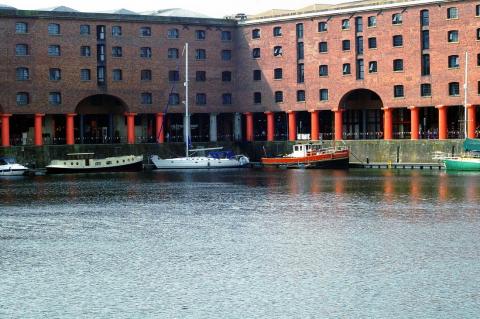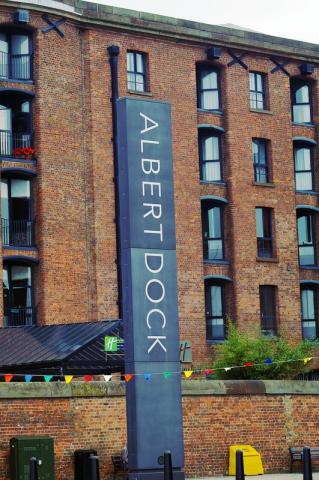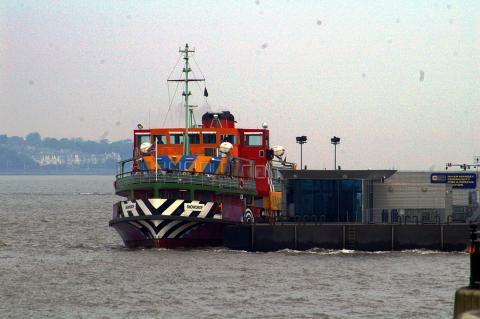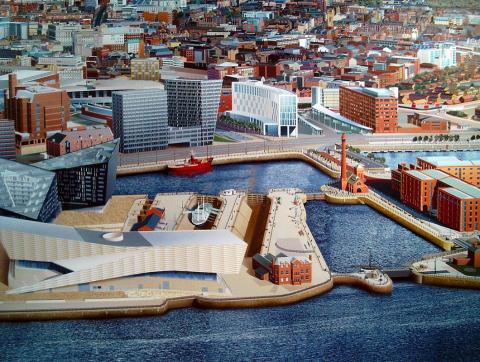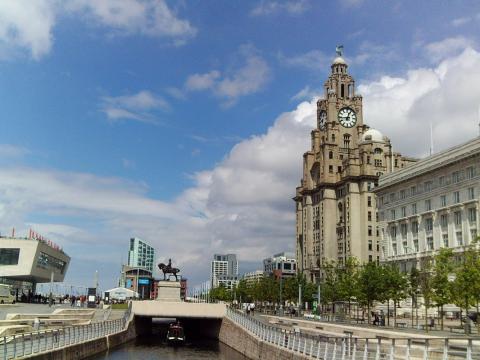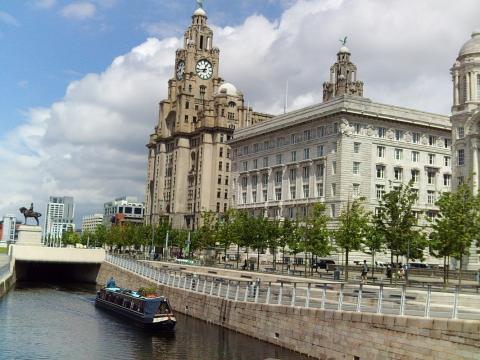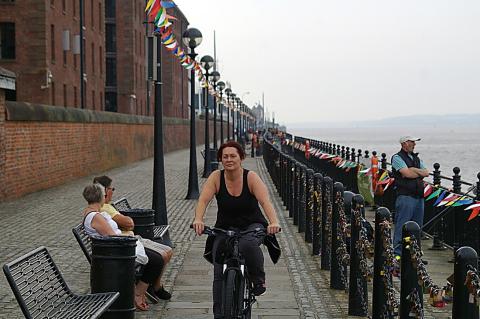Liverpool World Heritage status under threat
June 2017 - Any boater who has used Liverpool's new canal link through the old docks and spent time in Salthouse Dock will appreciate what a special place it is - but by next year it might no longer be a World Heritage site, as Peter Underwood reports.
UNESCO has issued its strongest warning to date that Liverpool risks losing its coveted ‘World Heritage’ status in 2018, unless the UK Government acts now to make major corrective changes to the way it manages the city’s historic waterfront, according to a national conservation group SAVE Britain’s Heritage, a group of architectural historians, writers, journalists and planners, which has been campaigning for historic buildings since 1975.
This is the first time a definitive date for deletion has been put forward by the international heritage organisation, and would be only the second time ever a cultural site has been deleted from the prestigious global list.
The Canal & River Trust manages the docks themselves and immediate surroundings in the historic docks but it says: “We don't have any land holdings around the docks. Just the waterspace. Obviously we want people to visit so are in favour of keeping the docks an attractive place for people to enjoy.”
Papers prepared for the July 2017 UNESCO World Heritage Committee meeting strongly criticise the Department of Culture, Media and Sport led by Secretary of State Karen Bradley for inadequate governance systems and planning mechanisms that threaten to undermine the protection of Liverpool’s World Heritage Site.
Liverpool became a World Heritage Site in 2004 for its outstanding universal value as, ‘the supreme example of a commercial port at the time of Britain's greatest global influence’. Its World Heritage Site stretches from the iconic Three Graces on the waterfront to St George’s Hall and Lime Street Station, and covers some 136 hectares of the city.
The city has been on the ‘World Heritage in Danger’ list since 2012 due to concerns about the harmful impact of large scale new development – namely the Liverpool Waters proposals. This highly contentious scheme would see construction of several skyscrapers along the waterfront, the tallest at 55 storeys. Unusually it has a planning permission valid until 2042.
Only two other countries in Europe have sites on the ‘in Danger’ list – Kosovo, and Georgia. Dresden is so far the only one of the 1,000 sites worldwide to have been stripped of its status.
The World Heritage Committee is to express, ‘its deep concern that the projects already approved as well as those approved in outline have actual and potential highly adverse and irreversible impacts on the OUV (Outstanding Universal Value) of the property.'
It adds that, 'it is also recommended that the Committee retain the property on the List of World Heritage in Danger but consider its deletion from the World Heritage List at its 42nd session in 2018', if the government doesn't stop the granting of planning permissions which have a negative impact and provide commitments to limitation on the quantity, location and size new skyscrapers
Henrietta Billings, Director of SAVE Britain’s Heritage, said: “This is a final warning shot for Liverpool and the British Government. International heritage status doesn’t just put Liverpool on the world stage, it brings cultural tourism, urban regeneration, and sustainable visitor attractions. Losing it because of crass planning decisions would be an international embarrassment as well as a hugely costly mistake.”
Professor John Belchem, Emeritus Professor of History at the University of Liverpool, who was closely involved in securing Liverpool’s World Heritage Site status, said: “Having led the way in regeneration through conservation and the cultural path to urban renewal and well-being, Liverpool has sadly lapsed into polarized and counterproductive opposition between redevelopment and heritage to the understandable concern of UNESCO.”
Jonathan Brown, Director of Liverpool-based planning and tourism consultancy Share the City, said: “Karen Bradley needs to get a grip on her advisors before this little local difficultly becomes an international incident. The UK usually honours her international treaty obligations, but UNESCO have clearly run out of patience with government assurances backed only by inaction. The United Nations expects the world’s cultural treasures to be safe in our hands, and a breach of the treaty would be noted with sadness around the world.”
Liverpool's response so far is an event aimed at 'securing and maximising Liverpool’s distinctive cultural identity'.
Organised by the University of Liverpool’s Heseltine Institute for Public Policy and Practice, in partnership with National Museums Liverpool and Liverpool City Council, the symposium will feature talks by big hitters, such as Phil Redmond CBE and Historic England Chief Executive, Duncan Wilson OBE.
It will hope to address the “deep concern” expressed this month by UNESCO over Liverpool Waters plans, and warnings that the city could lose its cherished World Heritage Status (WHS).
University of Liverpool’s Professor Lin Foxhall, who will speak at the event, said: “This is about ensuring our communities can make the most of this city’s wonderful heritage, and of course doing everything we can to make sure Liverpool keeps its World Heritage Status.
“It’s about looking at regeneration as part of making the city a more vibrant, more beautiful and more wonderful place to live, to benefit the economy and benefit people.
“We want Liverpool’s world class heritage to be accessible to the communities that live here, as well as the visitors we want to attract.
“It’s absolutely vital that we harness all the great work going on in the city to put the focus on how heritage can be part of regeneration.”
Cllr Ann O’Byrne, Deputy Mayor of Liverpool, said: “This symposium is a vital step in how the city engages more widely and develop the aims we identified in our new World Heritage Site (WHS) Management Plan.
“Improving the understanding of what the site represents and how the city can maximise the benefits of this asset are two fundamental issues we need to explore.
Dr David Fleming, Director of National Museums Liverpool, said: “Liverpool’s cultural heritage – its personality, its history, its buildings – is without equal outside of a handful of world cities (such as London, Paris and New York).
“The strength of this cultural heritage has enabled the renaissance of the city after the hard times of the 1960s, ‘70s and ‘80s. This was recognised to an important degree when, in 2004, UNESCO declared much of Liverpool city centre to be a World Heritage Site. Cities around the world would dearly love to be given this status. It is like the Oscar for heritage-rich cities.
“But Liverpool is now on a list that nobody wants to be on – the World Heritage in Danger List. Most of the In Danger sites are in Africa; others are in Syria and Iraq, for example.
“We must do all in our power to protect Liverpool’s coveted status, while at the same time ensuring that the city develops as a modern, 21st century city at the heart of a vibrant city region.”
The new WHS management plan, which has been endorsed by Historic England, will now be shared with UNESCO in July – but will it be enough with all those high-rise waterfront developments still having been given planning permission?
Photos: (1st) Inside the Albert Dock, (2nd) The old warehouses are now hotels, shops and apartments, (3rd) The iconic Mersey Ferry on the waterfront, (4th) The waterfront as seen by an artist and displayed in the Museum of Liverpool, (5th & 6th) A narrowboat passing through the Liverpool Link by the Three Graces, (7th) The water's edge separating the Albert Dock from the River Mersey.






